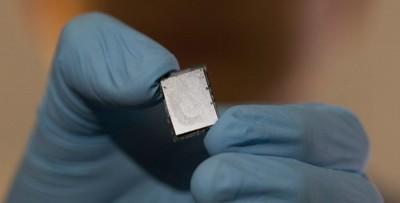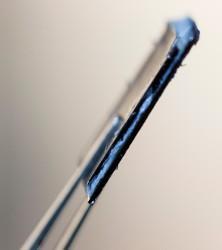 Close-up of structural supercapacitor. (Credit: Joe Howell / Vanderbilt University)
Close-up of structural supercapacitor. (Credit: Joe Howell / Vanderbilt University)Vanderbilt University scientists have developed a structural supercapacitor that efficiently stores electricity and can simultaneously bear mechanical load. This discovery has a wide range of potential applications, such as a laptop whose casing serves as its battery.
A structural supercapacitor that student Andrew Westover and Assistant Professor of Mechanical Engineering Cary Pint have made in Vanderbilt’s Nanomaterials and Energy Devices Laboratory stores electricity by assembling electrically charged ions on the surface of a porous material, instead of storing it in chemical reactions the way batteries do. As a result, supercaps can charge and discharge in minutes, instead of hours, and operate for millions of cycles, instead of thousands of cycles like batteries.
SEE ALSO: Wood Charcoal Can Be Used to Create Supercapacitors
In a paper appearing online May 19 in the journal Nano Letters (see footnote), Pint and Westover report that their new structural supercapacitor operates flawlessly in storing and releasing electrical charge while subject to stresses or pressures up to 44 psi and vibrational accelerations over 80 g (significantly greater than those acting on turbine blades in a jet engine).
Furthermore, the mechanical robustness of the structural supercapacitor doesn’t compromise its energy storage capability. “In an unpackaged, structurally integrated state our supercapacitor can store more energy and operate at higher voltages than a packaged, off-the-shelf commercial supercapacitor, even under intense dynamic and static forces,” Pint said.

Side view of a structural supercapacitor shows the blue polymer electrolyte that glues the silicon electrodes together. (Credit: Joe Howell / Vanderbilt University)
One area where supercapacitors lag behind batteries is in electrical energy storage capability: Supercaps must be larger and heavier to store the same amount of energy as lithium-ion batteries. However, the difference is not as important when considering multifunctional energy storage systems.
“Battery performance metrics change when you’re putting energy storage into heavy materials that are already needed for structural integrity,” said Pint. “Supercapacitors store ten times less energy than current lithium-ion batteries, but they can last a thousand times longer. That means they are better suited for structural applications. It doesn’t make sense to develop materials to build a home, car chassis, or aerospace vehicle if you have to replace them every few years because they go dead.”
Westover’s wafers consist of electrodes made from silicon that have been chemically treated so they have nanoscale pores on their inner surfaces and then coated with a protective ultrathin graphene-like layer of carbon. Sandwiched between the two electrodes is a polymer film that acts as a reservoir of charged ions, similar to the role of the electrolyte paste in a battery. When the electrodes are pressed together, the polymer oozes into the tiny pores in much the same way that melted cheese soaks into the nooks and crannies of artisan bread in a panini. When the polymer cools and solidifies, it forms an extremely strong mechanical bond.
“The biggest problem with designing load-bearing supercaps is preventing them from delaminating,” said Westover. “Combining nanoporous material with the polymer electrolyte bonds the layers together tighter than superglue.”
The use of silicon in structural supercapacitors is best suited for consumer electronics and solar cells, but Pint and Westover are confident that the rules that govern the load-bearing character of their design will carry over to other materials, such as carbon nanotubes and lightweight porous metals like aluminum.
The intensity of interest in “multifunctional” devices of this sort is reflected by the fact that the U.S. Department of Energy’s Advanced Research Project Agency for Energy is investing $8.7 million in research projects that focus specifically on incorporating energy storage into structural materials. There have also been recent press reports of several major efforts to develop multifunctional materials or structural batteries for use in electric vehicles and for military applications. However, Pint pointed out that there have not been any reports in the technical literature of tests performed on structural energy storage materials that show how they function under realistic mechanical loads.
Westover, A., Tian, J., Bernath, S., Oakes, L., Edwards, R., Shabab, F., Chatterjee, S., Anilkumar, A., & Pint, C. (2014). A Multifunctional Load-Bearing Solid-State Supercapacitor Nano Letters DOI: 10.1021/nl500531r
